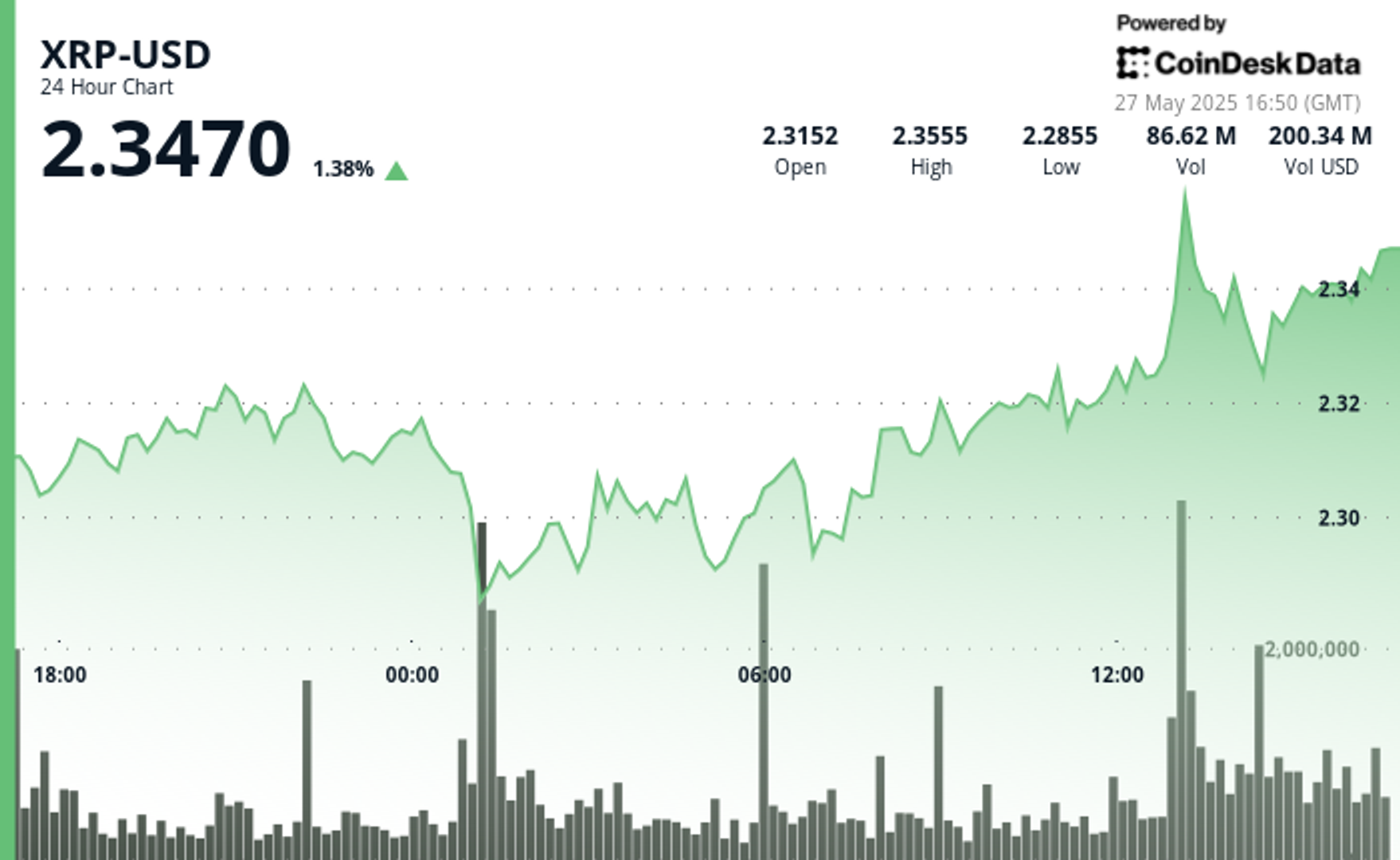Uncategorized
Sell the News: MicroStrategy Plunge Deepens in Days Following Nasdaq-100 Inclusion

In retrospect, it was inevitable.
Down more than 8% and holding just above $300 on Monday, MicroStrategy (MSTR) shares are now lower by about 30% since just after the announcement of their inclusion into the Nasdaq-100 index and nearly 50% from their late November record high.
The signs of at least a major short-term top in one-time barely known enterprise software company turned juggernaut Bitcoin Development Company MicroStrategy were everywhere.
First among those signals was the rocketing stock price — at its high of $543 in late November, MSTR was up nearly eight-fold in 2024 and more than a 50-bagger since the company began buying bitcoin (BTC) in August 2020.
There was also founder and Executive Chairman Michael Saylor — never shy about promoting his company’s prospects and evangelizing for Bitcoin — who late this year had somehow become even more ubiquitous on the financial news, podcast and social media carousels.
It wasn’t just the constant appearances, but subtle changes in Saylor’s attitude to what might charitably be described by U.S. sports fans as «spiking the football» following a touchdown. Among them was the constant promotion of the MicroStrategy-invented key performance indicator of «bitcoin yield,» which recalled late 1990s made-up internet bubble metrics like «page views.» His company flush with cash from share and convertible debt sales, Saylor — for reasons unknown — late in the year also got in the habit of teasing announcements of sizable new bitcoin purchases on the Sunday prior to the official regulatory filing on Monday morning.
And then there was the emergence of copycats. Despite years of the obvious success of Saylor’s bitcoin treasury strategy, there had been a decided lack of other publicly traded corporates adopting the same. Yes, a few — even large-caps like the Elon Musk-led Tesla and Jack Dorsey-led Square — had dipped their toes into bitcoin acquisition. No other company of note, though, was willing to not only adopt bitcoin as their main treasury asset but take advantage of willing markets to raise additional capital with which to accumulate tokens.
That changed in a sizable way this year however, with small cap medical device maker Semler Scientific, Japan hotel operator Metaplanet, and a number of bitcoin miners among those embracing the Saylor vision — each of them earning social media plaudits from Saylor with every capital raise and bitcoin purchase announcement.
If something cannot go on forever, it will stop
Not content with being maybe the greatest trader ever and accumulating many billions of dollars, George Soros wanted to be known as a great thinker. It’s no coincidence that his magnum opus on trading — the Theory of Reflexivity — sounds suspiciously similar to a famous theory from a fellow named Einstein.
Soros explained that investor perception and its effect on prices is a constant two-way street. In this way, perception (which is often wrong, as humans are fallible) can not just influence prices, but literally create its own reality, i.e. 1) investors believe a stock will go higher because earnings are about to get a big boost, 2) the stock price goes higher, 3) the high stock price allows management to raise capital at a cheaper cost than otherwise, 4) this improves earnings, 5) the stock price goes even higher, 6) the bulls pat themselves on the back for their brilliance and win over converts, … and so on.
Strip away much of Soros’ philosophy and this is also known as a virtuous circle, in which MicroStrategy had surely found itself in 2024. Part of Soros’ trading genius was recognizing these circles when they were happening and jumping on — in size. Another part of his genius was figuring out when the circles were about to break and getting out or even betting against them.
«If something cannot go on forever, it will stop,» said the late economist Herb Stein, who at the time was talking about government budget/trade deficits. Stein’s Law, it turns out, was equally applicable to MicroStrategy shares.
Scoreboard: still showing remarkable gains
Changing hands at about $430 just after the Dec. 14 announcement of its coming inclusion into the Nasdaq-100 Index, MicroStrategy is now selling at just above $300, a decline of roughly 30% in just two weeks.
Looking back, there appear to have been cracks in the MicroStrategy bubble three weeks earlier. The stock peaked at about $543 on Nov. 21. Despite bitcoin’s continued rise through late November and early December to an ultimate high above $108,000, MSTR lost ground — what technicians might call a troubling negative divergence. At the current $300, MicroStrategy for the moment is suffering a peak-to-trough drop of 45% in about five weeks.
MSTR shares have still put in a remarkable performance under anything except that very tiny time frame. They remain higher by more than 400% year-to-date and about 20-fold from the time Saylor initiated bitcoin purchases in August 2020.
While the bears might thus say the plunge has far to go, the bulls would surely point out that during MSTR’s run since August 2020, the stock has suffered a number of similar scary short-to-medium term declines and has always resolved higher.
What would Soros say? Just possibly, he would remind that his Theory of Reflexivity taught that prices can go further (both upward and downward) than most could possibly expect.
Uncategorized
MARA’s Fred Thiel Says U.S. Should Start Mining Bitcoin to Fill Strategic Reserve

LAS VEGAS, Nevada — Marathon Digital Holdings (MARA) CEO Fred Thiel has an idea for how U.S. President Donald Trump’s administration can make good on its promises to build out a strategic bitcoin reserve: start mining.
Speaking on a panel at Bitcoin 2025 in Las Vegas on Tuesday, Thiel said that the U.S. government has many potential ways to generate bitcoin to fill the strategic bitcoin reserve that would adhere to the “budget-neutral” acquisition strategy laid out in Trump’s March executive order, including using excess hydroenergy to mine bitcoin domestically.
Though it’s been nearly three months since Trump authorized the establishment of a strategic bitcoin reserve, it remains unclear exactly how — and when — the government will take steps to actually begin filling it, a source of evident frustration among a number of speakers at the conference.
“I think it’s critical,” Thiel said of acquiring bitcoin for the reserve. “The U.S. making a statement that we’re going to have a strategic reserve is an empty statement unless you start putting stuff into it.”
At this point, the reserve is supposed to hold all of the bitcoin that has been sized by the government in civil and criminal forfeitures — estimated to be approximately 200,000 bitcoins. But many in the industry and government, including Sen. Cynthia Lummis (R-Wyo.), think that getting the government’s existing stockpile of bitcoin into a strategic reserve is merely a first step, to be followed by bigger, more meaningful acquisitions.
In March, Lummis re-introduced legislation — the so-called BITCOIN Act of 2025 — aimed at codifying Trump’s plans for a strategic bitcoin reserve. Under Lummis’ plan, after getting all of the forfeited bitcoin into the reserve, the U.S. government would spend the next two to five years converting a portion of its gold certificates into bitcoin.
“We have enough assets in under performing assets that we can get five percent of the world’s bitcoin without spending a single dime,” Lummis said.
However, Lummis acknowledged that it’s unlikely that any real movement on the BITCOIN Act — or, more broadly, taking any significant steps to fill the strategic reserve with anything other than forfeited assets — will come before Congress works its way through stablecoin and market structure legislation.
“It’s going to be a heavier lift than I thought because so many people don’t understand bitcoin,” Lummis said.
Uncategorized
XRP Bounces Back as Bulls Defend Key Technical Support

Global economic tensions and trade disputes continue to influence cryptocurrency markets, with XRP demonstrating remarkable resilience despite recent capital outflows.
The digital asset saw its market capitalization fluctuate from $137.5 billion to $133.39 billion before partially recovering to $135.86 billion, highlighting the ongoing volatility.
Despite these challenges, XRP maintains position above critical technical support levels including the 50-day SMA at $2.26, suggesting underlying strength in its market structure.
Technical Analysis Highlights
- Price range: XRP traded between $2.275 and $2.356, representing a 3.56% range over 24 hours.
- Volume support: Significant volume spike to 71.18M at the $2.275 level during the 01:00 hour on May 27.
- Consolidation pattern: Hours following the initial support showed price consolidation before renewed buying.
- Secondary volume surge: Another high-volume increase to 74.36M during the 13:00 hour pushed prices toward range highs.
- Key resistance: Established at $2.355-$2.356 level.
- Support zone: Strong support identified at $2.275-$2.290 range.
- Hourly volatility: Notable price surge from $2.330 to $2.356 between 13:08-13:18.
- Volume confirmation: Exceptional volume spike of 6.28M at 13:13 supported the rally.
- Correction support: Price found support at $2.324 around 13:51 before recovering.
- Bullish pattern: Formation of a channel pattern with higher lows suggesting continued positive momentum.
External References
- «Possible Scenarios for XPR Once it Breaks Out of Consolidation: Ripple Price Analysis«, CryptoPotato, published May 26, 2025.
- «XRP price prediction as over $4 billion outflows in a day«, Finbold, published May 27, 2025.
- «XRP ($XRP) Price Prediction for May 28: Can Bulls Reclaim $2.32 After Prolonged Decline?«, Coin Edition, published May 27, 2025.
- «XRP Price Prediction For May 27«, CoinPedia, published May 27, 2025.
Uncategorized
KindlyMD Acquires 21 Bitcoin Ahead of Merger with Nakamoto

KindlyMD (NAKA), an integrated healthcare services provider, has pulled the trigger on its bitcoin BTC treasury strategy.
The acquired 21 bitcoin for roughly $2.3 million at an average cost of $109,027, according to a Tuesday press release. The purchase was funded by exercising some of the company’s outstanding warrants.
“Our first 1/millionth of all bitcoin, on our way to owning 1,000,000 bitcoin,” David Bailey, founder and CEO of Nakamoto Holdings, posted on X. “1 Nakamoto = 1m Bitcoin,” he added.
NAKA is higher by 3.9% on Tuesday.
KindlyMD announced on May 12 that it had agreed to merge with Nakamoto Holdings in order to pursue a bitcoin accumulation strategy mirrored after Strategy’s (MSTR) playbook. The combined entity secured $710 million in financing.
KindlyMD and Nakamoto will also partner up with custody firm Anchorage Digital to provide exclusive custody and trading services to the company post-merger, KindlyMD announced on May 21.
The merger is expected to close in the third quarter of 2025.
-

 Fashion7 месяцев ago
Fashion7 месяцев agoThese \’90s fashion trends are making a comeback in 2017
-

 Entertainment7 месяцев ago
Entertainment7 месяцев agoThe final 6 \’Game of Thrones\’ episodes might feel like a full season
-

 Fashion7 месяцев ago
Fashion7 месяцев agoAccording to Dior Couture, this taboo fashion accessory is back
-

 Entertainment7 месяцев ago
Entertainment7 месяцев agoThe old and New Edition cast comes together to perform
-

 Business7 месяцев ago
Business7 месяцев agoUber and Lyft are finally available in all of New York State
-

 Sports7 месяцев ago
Sports7 месяцев agoPhillies\’ Aaron Altherr makes mind-boggling barehanded play
-

 Entertainment7 месяцев ago
Entertainment7 месяцев ago\’Better Call Saul\’ has been renewed for a fourth season
-

 Sports7 месяцев ago
Sports7 месяцев agoSteph Curry finally got the contract he deserves from the Warriors





